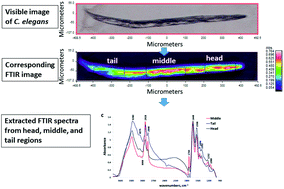Our official English website, www.x-mol.net, welcomes your
feedback! (Note: you will need to create a separate account there.)
FTIR imaging detects diet and genotype-dependent chemical composition changes in wild type and mutant C. elegans strains
Analyst ( IF 3.6 ) Pub Date : 2017-11-08 00:00:00 , DOI: 10.1039/c7an01432e A. Bouyanfif 1, 2, 3, 3, 4 , S. Liyanage 1, 2, 3, 3, 5 , J. E. Hewitt 3, 3, 5, 6 , S. A. Vanapalli 3, 3, 5, 6 , N. Moustaid-Moussa 1, 2, 3, 3, 4 , E. Hequet 1, 2, 3 , N. Abidi 1, 2, 3, 3, 5
Analyst ( IF 3.6 ) Pub Date : 2017-11-08 00:00:00 , DOI: 10.1039/c7an01432e A. Bouyanfif 1, 2, 3, 3, 4 , S. Liyanage 1, 2, 3, 3, 5 , J. E. Hewitt 3, 3, 5, 6 , S. A. Vanapalli 3, 3, 5, 6 , N. Moustaid-Moussa 1, 2, 3, 3, 4 , E. Hequet 1, 2, 3 , N. Abidi 1, 2, 3, 3, 5
Affiliation

|
This study focuses on the use of Fourier Transform Infrared (FTIR) microspectroscopy to determine chemical changes induced in the nematode Caenorhabditis elegans by supplementation of C. elegans maintenance media (CeMM) by Eicosapentaenoic acid (EPA). Wild-type C. elegans (N2) and mutant strains (tub-1 and fat-3) were grown in CeMM alone, and CeMM supplemented with EPA at 25 or 100 μM. Feeding was performed for 72 h. FTIR imaging was performed in transmission mode on individual worms. The FTIR imaging analysis of wild-type animals revealed the presence of vibrations assigned to unsaturated fatty acids, specifically bands at 3008 cm−1 (![[double bond, length as m-dash]](http://www.rsc.org/images/entities/char_e001.gif) C–H, olefinic stretch) and 1744 cm−1 (C
C–H, olefinic stretch) and 1744 cm−1 (C![[double bond, length as m-dash]](http://www.rsc.org/images/entities/char_e001.gif) O, unsaturated fatty acids). It confirmed previously reported synthesis of unsaturated fatty acids in wild-type C. elegans. For the FTIR spectra of mutant strains, these vibrations were absent or present only as very small shoulder, which indicates that tub-1 and fat-3 synthesize essentially saturated fatty acids as indicated by the presence of –CH2 and C
O, unsaturated fatty acids). It confirmed previously reported synthesis of unsaturated fatty acids in wild-type C. elegans. For the FTIR spectra of mutant strains, these vibrations were absent or present only as very small shoulder, which indicates that tub-1 and fat-3 synthesize essentially saturated fatty acids as indicated by the presence of –CH2 and C![[double bond, length as m-dash]](http://www.rsc.org/images/entities/char_e001.gif) O vibrations. These results are in agreement with previous studies which reported that these mutants have altered lipid compositions. Principal component analysis showed differences in chemical composition between wild-type and mutant strains as well as between mutant strains cultured in normal CeMM and those cultured in CeMM supplemented with EPA. This study demonstrated the usefulness of FTIR microspectroscopy to investigate fat metabolism in C. elegans.
O vibrations. These results are in agreement with previous studies which reported that these mutants have altered lipid compositions. Principal component analysis showed differences in chemical composition between wild-type and mutant strains as well as between mutant strains cultured in normal CeMM and those cultured in CeMM supplemented with EPA. This study demonstrated the usefulness of FTIR microspectroscopy to investigate fat metabolism in C. elegans.
中文翻译:

FTIR成像可检测野生型和秀丽隐杆线虫菌株中饮食和基因型相关的化学成分变化
这项研究的重点是利用傅里叶变换红外(FTIR)显微技术,通过添加二十碳五烯酸(EPA)补充秀丽隐杆线虫维持培养基(CeMM),来确定线虫秀丽隐杆线虫中诱导的化学变化。野生型秀丽隐杆线虫(N2)和突变株(tub-1和fat-3)仅在CeMM中生长,并在CeMM中添加25或100μM的EPA。进料进行72小时。FTIR成像是在单个蠕虫的传播模式下进行的。对野生型动物的FTIR成像分析显示存在不饱和脂肪酸,特别是3008 cm -1(![[双键,长度为m-破折号]](http://www.rsc.org/images/entities/char_e001.gif) CH,烯烃拉伸)和1744 cm处的振动-1(
CH,烯烃拉伸)和1744 cm处的振动-1(![[双键,长度为m-破折号]](http://www.rsc.org/images/entities/char_e001.gif) CO,不饱和脂肪酸)。它证实了先前报道的在野生型秀丽隐杆线虫中不饱和脂肪酸的合成。对于突变菌株的FTIR光谱,这些振动不存在或仅以很小的肩部出现,这表明tub-1和fat-3合成了基本饱和的脂肪酸,如–CH 2和C的存在所指示。
CO,不饱和脂肪酸)。它证实了先前报道的在野生型秀丽隐杆线虫中不饱和脂肪酸的合成。对于突变菌株的FTIR光谱,这些振动不存在或仅以很小的肩部出现,这表明tub-1和fat-3合成了基本饱和的脂肪酸,如–CH 2和C的存在所指示。![[双键,长度为m-破折号]](http://www.rsc.org/images/entities/char_e001.gif) O振动。这些结果与先前的研究一致,后者报道了这些突变体已经改变了脂质组成。主成分分析表明,野生型和突变型菌株之间以及在正常CeMM中培养的突变株与在添加EPA的CeMM中培养的突变株之间的化学成分存在差异。这项研究证明了FTIR显微学在研究秀丽隐线虫中脂肪代谢方面的有用性。
O振动。这些结果与先前的研究一致,后者报道了这些突变体已经改变了脂质组成。主成分分析表明,野生型和突变型菌株之间以及在正常CeMM中培养的突变株与在添加EPA的CeMM中培养的突变株之间的化学成分存在差异。这项研究证明了FTIR显微学在研究秀丽隐线虫中脂肪代谢方面的有用性。
更新日期:2017-11-15
![[double bond, length as m-dash]](http://www.rsc.org/images/entities/char_e001.gif) C–H, olefinic stretch) and 1744 cm−1 (C
C–H, olefinic stretch) and 1744 cm−1 (C![[double bond, length as m-dash]](http://www.rsc.org/images/entities/char_e001.gif) O, unsaturated fatty acids). It confirmed previously reported synthesis of unsaturated fatty acids in wild-type C. elegans. For the FTIR spectra of mutant strains, these vibrations were absent or present only as very small shoulder, which indicates that tub-1 and fat-3 synthesize essentially saturated fatty acids as indicated by the presence of –CH2 and C
O, unsaturated fatty acids). It confirmed previously reported synthesis of unsaturated fatty acids in wild-type C. elegans. For the FTIR spectra of mutant strains, these vibrations were absent or present only as very small shoulder, which indicates that tub-1 and fat-3 synthesize essentially saturated fatty acids as indicated by the presence of –CH2 and C![[double bond, length as m-dash]](http://www.rsc.org/images/entities/char_e001.gif) O vibrations. These results are in agreement with previous studies which reported that these mutants have altered lipid compositions. Principal component analysis showed differences in chemical composition between wild-type and mutant strains as well as between mutant strains cultured in normal CeMM and those cultured in CeMM supplemented with EPA. This study demonstrated the usefulness of FTIR microspectroscopy to investigate fat metabolism in C. elegans.
O vibrations. These results are in agreement with previous studies which reported that these mutants have altered lipid compositions. Principal component analysis showed differences in chemical composition between wild-type and mutant strains as well as between mutant strains cultured in normal CeMM and those cultured in CeMM supplemented with EPA. This study demonstrated the usefulness of FTIR microspectroscopy to investigate fat metabolism in C. elegans.
中文翻译:

FTIR成像可检测野生型和秀丽隐杆线虫菌株中饮食和基因型相关的化学成分变化
这项研究的重点是利用傅里叶变换红外(FTIR)显微技术,通过添加二十碳五烯酸(EPA)补充秀丽隐杆线虫维持培养基(CeMM),来确定线虫秀丽隐杆线虫中诱导的化学变化。野生型秀丽隐杆线虫(N2)和突变株(tub-1和fat-3)仅在CeMM中生长,并在CeMM中添加25或100μM的EPA。进料进行72小时。FTIR成像是在单个蠕虫的传播模式下进行的。对野生型动物的FTIR成像分析显示存在不饱和脂肪酸,特别是3008 cm -1(
![[双键,长度为m-破折号]](http://www.rsc.org/images/entities/char_e001.gif) CH,烯烃拉伸)和1744 cm处的振动-1(
CH,烯烃拉伸)和1744 cm处的振动-1(![[双键,长度为m-破折号]](http://www.rsc.org/images/entities/char_e001.gif) CO,不饱和脂肪酸)。它证实了先前报道的在野生型秀丽隐杆线虫中不饱和脂肪酸的合成。对于突变菌株的FTIR光谱,这些振动不存在或仅以很小的肩部出现,这表明tub-1和fat-3合成了基本饱和的脂肪酸,如–CH 2和C的存在所指示。
CO,不饱和脂肪酸)。它证实了先前报道的在野生型秀丽隐杆线虫中不饱和脂肪酸的合成。对于突变菌株的FTIR光谱,这些振动不存在或仅以很小的肩部出现,这表明tub-1和fat-3合成了基本饱和的脂肪酸,如–CH 2和C的存在所指示。![[双键,长度为m-破折号]](http://www.rsc.org/images/entities/char_e001.gif) O振动。这些结果与先前的研究一致,后者报道了这些突变体已经改变了脂质组成。主成分分析表明,野生型和突变型菌株之间以及在正常CeMM中培养的突变株与在添加EPA的CeMM中培养的突变株之间的化学成分存在差异。这项研究证明了FTIR显微学在研究秀丽隐线虫中脂肪代谢方面的有用性。
O振动。这些结果与先前的研究一致,后者报道了这些突变体已经改变了脂质组成。主成分分析表明,野生型和突变型菌株之间以及在正常CeMM中培养的突变株与在添加EPA的CeMM中培养的突变株之间的化学成分存在差异。这项研究证明了FTIR显微学在研究秀丽隐线虫中脂肪代谢方面的有用性。











































 京公网安备 11010802027423号
京公网安备 11010802027423号